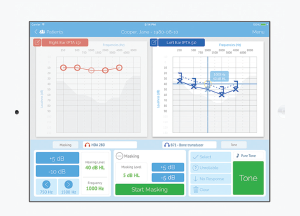
Outpatient building block at Christian Medical College in Velore, India.
Editor’s note: This article is part two of a two-part series on Dr. Yalamanchali’s medical service trip to India. Part one was published in the May 2018 issue of ENTtoday.
Explore This Issue
June 2018At the end of my research month in India, I spent my last weekend with my grandmother. For the first six years of my life, I lived in India with my grandmother while my parents completed their medical training. My grandmother and I have an unbreakable connection, and watching old age and Parkinson’s catch up with my vibrant grandmother is quite difficult.
No matter how tired she may be feeling, her greatest joy comes from feeding us, and every morning she still wakes up before sunrise to cook for the day. Over the last few years, she has complained of hearing loss and, even with my persistence, refused a formal hearing test to avoid hospitals. With the Shoebox Audiometer, she was able to undergo an audiogram in the comforts of her own home.
Portable Hearing Testing
The prevalence of disabling hearing loss is far greater today than in 1990 when the first Global Burden of Disease Study was performed. In 2015, hearing loss was the fourth-leading cause of years lived with disability. Hearing loss over time causes enormous economic and personal consequences in both children and adults. The literacy rate is worse in children with hearing loss when compared to their normal-hearing peers, with significant compromise in education attainments. Adults with hearing loss may have a sense of profound isolation and may withdraw from society and family interactions (Lancet. 2017;390:2503–2515).

Interface for the Shoebox portable audiometer.
If diagnosed early enough, 50% of hearing loss can be prevented and most of the remainder can be treated effectively, according to the WHO. An audiogram in a sound-treated booth sets the gold standard for the diagnosis of hearing loss. However, access is frequently limited by financial, geographical, and logistical constraints (J Amer Acad Audiol. 2013:24:407–416). To fill this gap, cost-effective and user-friendly alternatives such as tablet computers with calibrated headphones have been developed to perform portable audiograms outside of the conventional audio booth. These devices have been validated in different populations, ranging from children to adults, in various countries such as Brazil, Canada, and Ethiopia.
Specifically, the Shoebox portable tablet audiometer, which was used in our study, can perform interactive tests such as conditioned play audiometry and diagnostic hearing testing. Given the significant burden of chronic ear disease in South India, the goal of my project was to validate the Shoebox audiometer in the South Indian population, with the long-term goal of improving access to hearing healthcare.
At Christian Medical College (CMC) in Vellore, India, patients in clinic who met indications for a conventional audiogram also subsequently underwent a portable audiogram. The results of the portable audiogram were then compared with the results of the conventional audiogram. Both air conduction and bone conduction testing were performed, and masking techniques were employed with the portable audiograms in a regular clinic office to mimic outreach clinic settings. Our preliminary data show that overall sensitivity and specificity for the tablet are 89%(95%CI: 80% to 94%) and 70%(95%CI: 56% to 82%), respectively. It can accurately identify hearing impairment and can be used as a screening tool for hearing loss in low-resource settings.

Dr. Yalamanchali’s amamamma (her mother’s mother) using the Shoebox portable audiogram.

Dr. Yalamanchali on her last day at Modale Hostel.
The portable audiogram was further used in rural clinics around CMC and was fairly easy to transfer, delivering hearing services to areas that previously lacked, but needed, such testing. For example, an inpatient portable audiogram was performed in a rural hospital on an elderly woman. She was noted to have significant sensorineural hearing loss. A printout of the audiogram could then be used to help her obtain hearing aids, with the aid of some monetary plans in that specific rural area. Furthermore, local audiology students, audiologists, and otolaryngology residents were easily trained to use the portable audiogram and could administer tests without any barriers.

Main entrance to the
CMC campus.
Overcoming Stigmas
When my grandmothers’ friends learned that I was able to perform an audiogram at home, they all came over for lunch on a Saturday and waited excitedly and anxiously for me to test their hearing. They were reluctant to enter a hospital for a hearing testing, although in reality all of my grandmothers’ friends were worried about their hearing and wanted testing. We discussed hearing aids and, once the stigmas related to hearing aids were dissipated and the audiograms completed and reviewed, showing varying degrees of hearing loss, my grandmother and her friends seemed more at ease and willing to try hearing aids. The same barriers and stigmas related to hearing testing and hearing aids are found in our own community in the United States and, while the portable audiogram is a great tool for hearing testing, it is also a valuable tool for patient education.
Overall, our study and other previously published studies demonstrate the practical and efficient use of portable audiometry in many different settings. In children in remote settings, it can help with early detection and treatment, and with adults it can remove the initial barrier of a hospital visit and improve awareness of hearing loss and its sequelae.
Sreeya Yalamanchali, MD, is a fourth-year resident in the University of Kansas Department of Otolaryngology–Head and Neck Surgery. Read more about Dr. Yalamanchali’s medical service trip to Vellore, India on the KU ENT Global Health blog.
